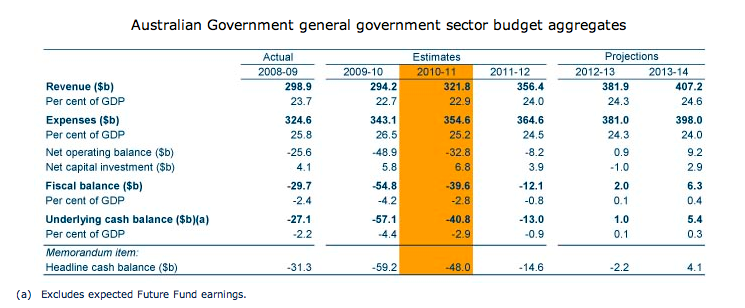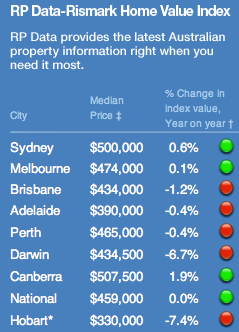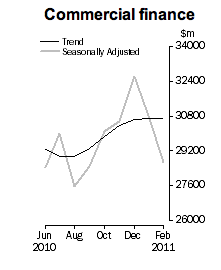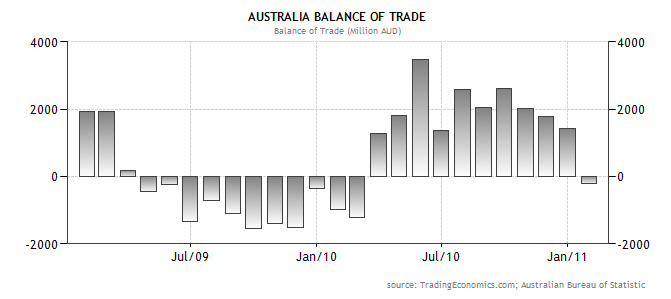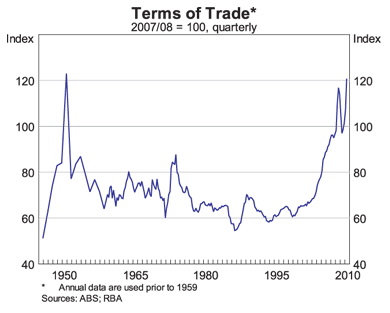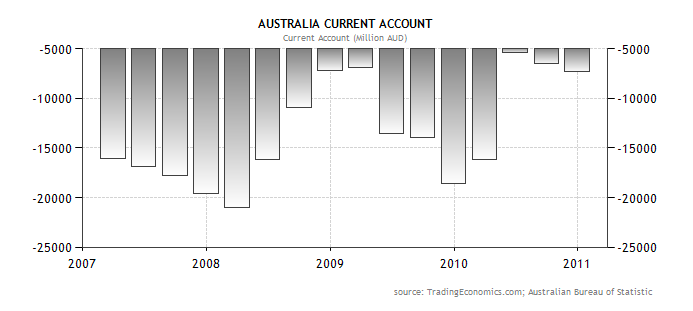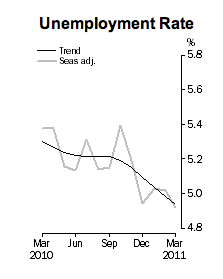It is that time of year again where the government, specifically the treasurer gets to tell you what a wonderful job they/he are doing. This year the Treasurer seems to be using the old “it was the last guys fault” strategy to cover up his own inadequacies. His latest speech in Brisbane was a definitely a “softening up” affair.
The real show is taking place at 7:30pm on 10th of May. It is still far too early in the spin cycle for any specific details, but it seems that Wayne Swan has taken the approach of “soften early, sweeten later”.
First the overview. It is estimated that the budget will be $321.8 for 10/11 FY with the underlying plan being to get rid of the government deficit.
The governments mandate for itself is:
Setting the highest standards for responsible fiscal management
- Strict adherence to the fiscal strategy sees the budget return to surplus in 2012‑13, three years ahead of schedule
- All new spending is offset, and real payments growth has been held to below two per cent
- The forecast Budget deficit of $40.8 billion in 2010‑11 is $16.3 billion less than expected one year ago
- Net debt is projected to peak at just 6.1 per cent of GDP; half of the level projected a year ago and less than one tenth of the average across the major advanced economies
Returning to surplus and paying off debt even sooner
- Return to surplus in three years, three years earlier than expected and ahead of all the major advanced economies
- The Government will continue building surpluses and achieving a rapid reduction in net debt
- The Government will maintain the 2 per cent cap on real spending growth, on average, until the surplus reaches 1 per cent of GDP
Tackling key policy challenges and consolidating the position of strength that Australia enjoys
- The Budget ensures that fiscal policy settings remain appropriate, given the strength of the economic recovery
- It takes steps to deal with a return to full capacity by growing the whole economy and harnessing the potential of the resources boom
- It builds on the investments in skills and infrastructure that are necessary to secure our future prosperity
- It begins the task of modernising the tax system, boosts national savings, makes new investments in renewable energy; and funds historic reforms to the health system
Continuing to ease the burden for working families
- The Budget builds on the Government’s progress in helping working families make ends meet, delivering the third tranche of income tax cuts
- Tax reforms that grow the economy and real wages over time, putting more in the pocket of working families
- Fairer and simpler tax returns that increase after‑tax income for 6.4 million Australians
I have been slowly reading through the budget documentation and the thing that has struck me is how much the recent economic news is straining the forecasts. So for part one of “budget watch” I thought I would go through each of the forecasts and analyse how well they are holding up to that strain. The budget forecasts are as follows:
Forecast 1. The world economy is experiencing a nascent and uneven recovery. It is expected to grow by 4¼ per cent in both 2010 and 2011, led by a resurgence of growth in the developing Asian economies. A prolonged period of financial sector balance sheet repair and fiscal consolidation will act as a drag on recovery in the advanced economies. The potential for the sovereign debt crisis in Greece to spread to other countries and seriously impact broader financial markets is a significant risk for the world economy.
Analysis: The latest IMF world economic report states:
The world economic recovery continues, more or less as predicted. Indeed, our growth forecasts are nearly unchanged since the January 2011 WEO Update and can be summarized in three numbers: We expect the world economy to grow at about 41⁄2 percent a year in both 2011 and 2012, but with advanced economies growing at only 21⁄2 percent while emerging and developing economies grow at a much higher 61⁄2 percent.
That certainly seems to match the forecast, which is no surprised given global economic forecasts would be drawn from this very source. I note that in recent days European risk has become far more immediate and just today the EU is having to defend Greece against default rumours as bonds plunge.
Forecast 2. Australia’s real GDP is forecast to grow by 3¼ per cent in 2010‑11 and 4 per cent in 2011‑12. The main contributors to economic growth are expected to be household consumption, business investment and exports. Public sector demand will ease as the fiscal stimulus is withdrawn.
Analysis: Well they are in trouble with this one. April 16 – The OZ
Confidential Treasury figures showing a $13 billion fall in economic growth this financial year are expected to force drastic cuts to the government’s May budget. Treasurer Wayne Swan will announce forecast growth of just 2.25 per cent, much lower than the 3.25 per cent forecast in November and below the 2.5 per cent canvassed in budget meetings just weeks ago, Fairfax newspapers say.
With the Australian economy worth $1.3 trillion a year, a one per cent fall in growth amounts to a $13 billion hit, Fairfax says.The weaker outlook means Mr Swan will be under greater pressure to find budget cuts to offset revenue losses in 2011-12.
Forecast 3. Household consumption is expected to continue to recover. A strong labour market, sustained improvements in consumer confidence and higher asset prices are expected to see household consumption grow by 3½ per cent in 2010‑11 and 4 per cent in 2011‑12.
Analysis: The labour market part was definitely correct and consumer confidence is resilient. However I wouldn’t define asset prices as “higher”. The RPData tree was all green 6 months ago it now looks like this.
The rest is a bit more difficult to calculate because the national accounts only come about every 6 months. In the last national accounts household expenditure did look as if it was almost in line with this prediction and recent car sales data was positive. However, retail sales growth has been on lower than historic trend and we have seen a number of announcements from retailers expressing concern about the lack of spending in 2011. It is also well known that the savings rate is up. This however is anecdotal until we see the figures. As noted this morning on MacroBusiness Wayne Swan himself said.
The economy also suffers from a hangover of the global financial crisis, tighter credit conditions, subdued consumer spending, a high Australian dollar that is hurting some industries, and the impact of this summer’s natural disasters in the short term.
Which all point to subdued consumption.
Forecast 4. Dwelling investment is forecast to grow by a strong 7½ per cent in 2010‑11. There is currently a significant pipeline of dwelling construction work to be completed. Strong population growth and low vacancy rates should continue to support activity in the dwelling sector, although this is likely to be tempered by higher mortgage interest rates.
Analysis: No surprise here. Dwelling approvals are not good.
and the leading indicator for residential construction, the purchase of new land is in the toilet as noted in the OZ yesterday.
Land sales have collapsed to their lowest level in a decade as local councils fail to keep up with land release and buyers resist rising costs. Figures compiled by the Housing Industry Association and RP Data show only 11,500 blocks of land were sold around the country in the December quarter, down by 40 per cent from a year earlier.
Forecast 5 . Business investment is expected to rise significantly in both 2010‑11 and 2011‑12. The Small Business and General Business Tax Break has supported machinery and equipment investment in recent times, but strong business confidence and easing credit conditions are expected to support a broader‑based recovery, recent interest rate increases notwithstanding. A surge in new mining investment is expected as a number of large projects come on line. Non‑residential building investment is expected to remain subdued before recovering in response to the broader economic recovery.
Analysis: Private Capex is one of those areas where the hype hasn’t yet met reality. The forecast is for a “significant rise” which as of recent figures that has not occurred.
New private capital expenditure rose 1.3 per cent in real terms, seasonally adjusted, in the December quarter, according to official figures.The median market forecast was for a rise of 2.2 per cent in the quarter.
The fifth estimate of expenditure for 2010/11 was $128.931 billion, which is 16.2 per cent higher than the fifth estimate for 2009/10, the Australian Bureau of Statistics (ABS) said
Although large components of capex do not use banking finance, it must also be noted that commercial finance is not doing too well either, suggesting further weakness ahead, at least outside the mining majors.
Forecast 6: Public final demand, having risen strongly in 2009‑10, is forecast to moderate in 2010‑11 and 2011‑12, reflecting the unwinding of the Government’s fiscal stimulus measures and a broader moderation in spending growth across other levels of government.
Analysis: I am going to give them a tick for this one, but at the stage the country is at in the economic cycle I am not sure that is a good thing. With the loss of government stimulus spending and the mandated aim for a surplus budget this was a bit of a no brainer. The problem however is that there are major flow-on effects from this forecast success. The natural disasters in Queensland, NSW and Victoria have led to significant budget issues for the State governments. On top of that we have the slow down in housing sales which again adds to the state’s woes. Victoria has been served a double whammy in regards to this but they are not alone. In my own State of Queensland I am aware that government departments have been asked to find significant savings ( 15% + ) in next year’s budget. I suspect this will mean large falls in corporate expenditure. The private sector may not have noticed yet as projects rush to meet their June 30 spending deadlines, but after July 1, I think many IT, HR and finance consultancies are in for a rude shock as state government contracts suddenly dry up.
Forecast 7: Exports are forecast to grow solidly in both 2010‑11 and 2011‑12, as the world economy continues to strengthen and new resources production comes on line. The recovery in exports is expected to be broad‑based, but with particular strength in non‑rural commodity exports.
Analysis: Not too sure about that “broad-based” bit. Farm sector exports are relatively flat in real terms, and other non-mining exports are being clobbered by the high Australian dollar. It is all eggs in one basket, and that basket is China.
Forecast 8: Imports are expected to increase strongly in both 2010‑11 and 2011‑12, reflecting rising domestic demand and a strong Australian dollar. The growth in imports is expected to be broadly based, although the contribution of capital goods imports — driven by the capital expenditure of major mining projects — is expected to be substantial.
Analysis: The high AUD is certainly pushing up the value of imports, but again we are not seeing the large capex rises that the government is expecting. Although this forecast is mostly correct I find it almost cringe worthy that with terms of trade at historic highs the balance of trade chart looks like this.
This certainly supports the “hollowing out” meme that you would have heard on MacroBusiness.
Forecast 9: Terms of trade are forecast to rise by 14¼ per cent in 2010‑11 to their highest level in 60 years, largely due to strong price rises for Australia’s iron ore and coal exports, driven by a recovery in global demand. Commodity prices are expected to moderate somewhat in 2011‑12, but still remain at high levels. High commodity prices have caused a substantial supply response and this will increasingly weigh on prices as supply comes on stream. The medium‑term projections assume that the terms of trade will fall over the medium term, as world supply increases.
Analysis: No arguments here. But given that the government is already forecasting medium term falls in terms of trade you have to wonder exactly where the long term strategy is. I certainly don’t hear Wayne Swan gushing long term economic strategic planning.
Forecast 10: Current account deficit is forecast to narrow in 2010‑11, reflecting the expected sharp rise in the terms of trade, before expanding to 5 per cent of GDP in 2011‑12 in response to rising import volumes and a modest fall in the terms of trade. The higher terms of trade are expected to push the trade balance into temporary surplus in 2010‑11, although the trade balance is expected to return to deficit in 2011‑12. The net income deficit is expected to widen over the forecast period, as improved export earnings generate increased equity income outflows.
Analysis: I’ll be kind and give them this one. The CAD never did make it to surplus and it is now on the way back down again. But with the import and export forecasts being correct this one is close enough.
Forecast 11: Unemployment rate is expected to continue to fall, reaching 5 per cent by the end of 2010‑11 and 4¾ per cent by the end of 2011‑12, around its full employment rate. Employment is expected to grow by 2¼ per cent through the year to the June quarter 2011 and 2 per cent through the year to the June quarter 2012, absorbing strong growth in the labour force associated with rapid growth in the working age population and an expected increase in the participation rate.
Analysis: So far, spot on. Give that treasury forecaster a pay rise. I am, however, a little concerned about future predictions. Falling rates of credit issuance are usually a leading indicator of employment issues, and the some parts of Australian are already showing signs of this. But for now the forecast is correct and I am a “fringe dwelling loonie”.
Forecast 12: Wages growth is expected to recover after growing close to its slowest rate on record through 2009. The Wage Price Index is expected to grow by 3¾ per cent through the year to the June quarter 2011 and 4 per cent through the year to the June quarter 2012.
Analysis: The latest data from the ABS has the Wage Price Index up 3.9 per cent for the December quarter. The growth however is unbalanced with the mining sector up 4.5%.
Forecast 13: inflation is expected to stabilise at around 2½ per cent through 2010‑11 and 2011‑12. Headline inflation is expected to be 3¼ per cent through the year to the June quarter 2010 and 2½ per cent through the year to the June quarter of both 2011 and 2012.
Analysis: The latest CPI is 2.7%.
Overall Conclusion: The government seems to have done a fairly good job of predicting most of the macro economic influences on the budget. Exports, imports, inflation, ToT and employment are all in-line with predictions. However, they have stumbled significantly with private debt dynamics. They certainly did not predict the very large influence that a change in private sector credit issuance and associated spending patterns would have on the budget. Although members of MacroBusiness has been warning about this for some time I am not really surprised by the failure of the government to notice the issue. This is the same thing that side-swiped many other comparable economies over the last few years. Dr Bernanke has been made famous by his complete disregard for private sector debt dynamics while the US economy imploded around him.
From Mr Swan’s speech today, I detect that he doesn’t quite understand what the problem is, and I see little evidence that the government is about to launch into another stimulus program to kick start credit. In fact, the reverse is clearly true. As I said in my analysis of Forecast 6, this lack of new stimulus will have significant flow-on effects to downstream economic participants.
So long as the government’s ignorance of the effects of disleveraging continue, they will be at risk of severe embarrassment as the economy continues to underperform.
